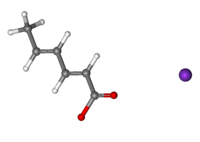Potassium sorbate
 |
|
 |
|
| Names | |
|---|---|
|
IUPAC name
Potassium (2E,4E)-hexa-2,4-dienoate
|
|
| Other names
E202
Sorbistat-K Sorbistat potassium |
|
| Identifiers | |
|
24634-61-5 |
|
| 3D model (Jmol) | Interactive image |
| ChEBI |
CHEBI:77868 |
| ChemSpider |
4445644 |
| ECHA InfoCard | 100.042.145 |
| E number | E202 (preservatives) |
| KEGG |
D02411 |
| PubChem | 23676745 |
|
|
|
|
| Properties | |
| C6H7KO2 | |
| Molar mass | 150.22 g·mol−1 |
| Appearance | White crystals |
| Odor | yes |
| Density | 1.363 g/cm3 |
| Melting point | 270 °C (518 °F; 543 K) (decomposes) |
| 58.5 g/100 mL (100 °C) | |
| Solubility in other solvents | Soluble in ethanol, propylene glycol
Slightly soluble in acetone Very slightly soluble in chloroform, corn oil, ether Insoluble in benzene |
| Hazards | |
| NFPA 704 | |
| Lethal dose or concentration (LD, LC): | |
|
LD50 (median dose)
|
4340 mg/kg (oral, rat) |
|
Except where otherwise noted, data are given for materials in their standard state (at 25 °C [77 °F], 100 kPa).
|
|
|
|
|
| Infobox references | |
Potassium sorbate is the potassium salt of sorbic acid, chemical formula CH3CH=CH−CH=CH−CO2K. It is a white salt that is very soluble in water (58.2% at 20 °C). It is primarily used as a food preservative (E number 202). Potassium sorbate is effective in a variety of applications including food, wine, and personal-care products. While sorbic acid is naturally occurring in some berries, virtually all of the world's production of sorbic acid, from which potassium sorbate is derived, is manufactured synthetically.
Potassium sorbate is produced industrially by neutralizing sorbic acid with potassium hydroxide. The precursor sorbic acid is produced in a two-step process via the condensation of crotonaldehyde and ketene.
Potassium sorbate is used to inhibit molds and yeasts in many foods, such as cheese, wine, yogurt, dried meats, apple cider, soft drinks and fruit drinks, and baked goods. Its breakdown to sorbitol, a sugar alcohol, has been shown to increase the chances of a bowel movement from eating prunes. It is used in the preparation of items such as maple syrup and milkshakes served by fast-food restaurants such as McDonald's. It can also be found in the ingredients list of many dried fruit products. In addition, herbal dietary supplement products generally contain potassium sorbate, which acts to prevent mold and microbes and to increase shelf life. It is used in quantities at which no adverse health effects are known, over short periods of time. Labeling of this preservative on ingredient statements reads as "potassium sorbate" or "E202". Also, it is used in many personal-care products to inhibit the development of microorganisms for shelf stability. Some manufacturers are using this preservative as a replacement for parabens. Tube feeding of potassium sorbate reduces gastric burden of pathogenic bacteria.
...
Wikipedia

